Jump to:
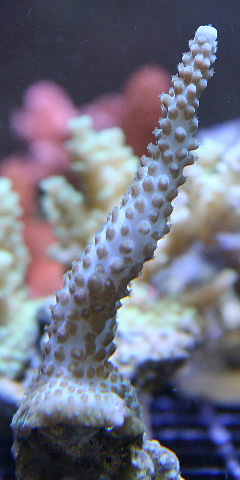
Introduction
Acroporidae corals are not only the most popular SPS (small-polyped stony) corals for the saltwater hobbyist, but these corals are also the largest contributor to building the coral reefs worldwide. Although all stony corals (and even some soft corals) are hermatypic, Acroporidae corals account for a third of the reef builders. Acroporidae are a small polyp stoney coral and because of advancements in the saltwater aquarium hobby are now a more commonly kept coral. Acroporidae corals are in the order Scleractinia (stony corals) and the subclass Hexacorallia (or also known as Zoantharia). Being in the Hexacorallia subclass means that the polyps have tentacles in multiples of six.

Acroporidae corals are polytrophic. They gain their energy from their zooxanthellae (dinoflagellate algae) and from capturing prey such as zooplankton. They cannot survive on photosynthesis alone. However, that being said, you will not need to directly feed these corals in your reef aquarium. If there is a healthy planktonic population, it will be enough to sustain your Acroporidae coral. Brine shrimp and pureed meaty aquarium supplements that are used to feed LPS corals are too large to feed SPS corals. Many marine aquarist have success with a refugium/sump to encourage the growth of plankton</a >. Acroporidae can then feed on zooplankton such as amphipods or dinoflagellates.
Genera
Acropora
Check our current stock</a >Common Species: A. millepora, A. formosa</em >, A. nobilis, A. caroliniana, A. hyacinthus, A. palmata, A. granulosa, A. longicyathus, A. yongei, and many, many more!</em >

Common names for Acropora corals include staghorn coral, cat's paw coral, elkhorn coral, table coral, tabletop coral, and bottlebrush coral. Some coral retailers mistakenly list a species of Acropora coral as Millepora. Millepora corals are actually fire corals. What these coral retailers are referring to are Acropora millepora, and should not be confused. Corals in this genus may be difficult to identify, as many species will take on more than one type of growth form in their life cycle. Younger coral specimens are particularly hard to distinguish. Many aquacultured species of Acropora are available as small encrusting mats that have yet to put forth any branches or clusters. Some of the major growth forms found for Acropora spp. are branching (the staghorns), bushy, clustered, fingered, columnar, laminar (tabletops), and bottlebrushes.
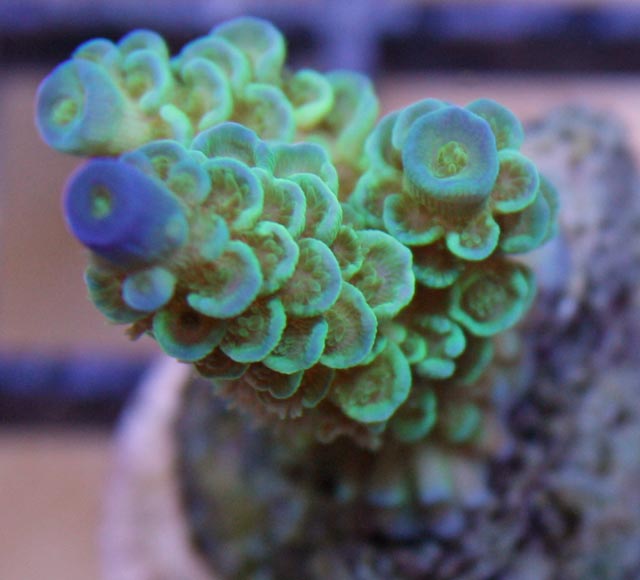
Acropora corals are known for their axial corallites (the part of the skeleton that houses the polyp). Their axial corallites (located at the tip of a branch or finger) are fast growing and do not contain zooxanthellae. Instead, it is supported by the rest of the colony while it rapidly out-competes neighboring corals. The axial corallite is tube shaped. (Seen from above, it is reminiscent of a pig snout with one nostril.) As the corallite grows, radial corallites form at its base and all along its “stem”. At times, one of the radial corallites will become an axial corallite, branching off from the main stem. As the axial corallite is devoid of zooxanthellae, it is white or brightly colored in contrast. When it is colored, it possesses pigments from the rest of the colony, such as Pocilloporin.
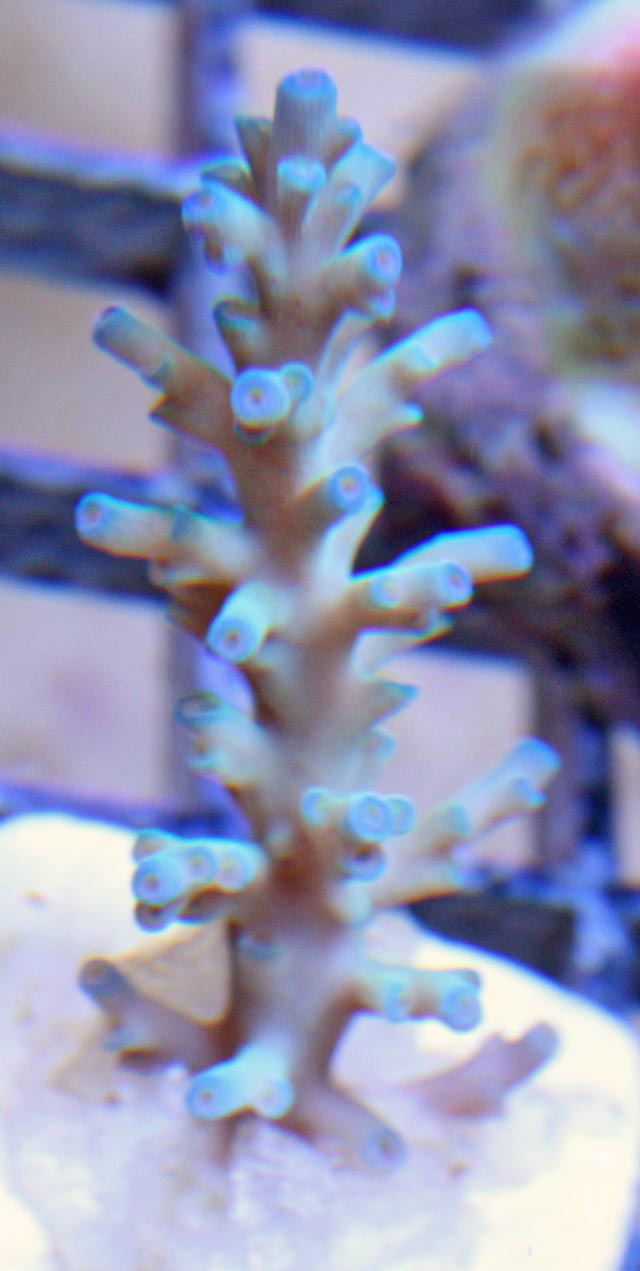
Acropora corals are often the dominant genus on a reef in the Pacific ocean. There are only 3 species in the Atlantic ocean and are currently unavailable in the saltwater hobby due to their protected status. Normally, Acropora spp. are found in water with a strong current and high light intensity, such as on the fore-reef slope, reef crests, or reef flats. These corals tolerate exposure to air during low tide and have a heavy mucus coating to cope with the stress. Acropora corals can be difficult to keep for the beginner aquarist. Partially because they are particularly sensitive to varying temperatures, chemicals, and sediment and these corals do better in more mature aquariums with a stable marine environment. Aqua cultured varieties of these corals are more successful than wild collected coral specimens. Acropora corals are also vulnerable to rapid tissue necrosis, black- & white-band disease, bleaching, and many more saltwater aquarium maladies.
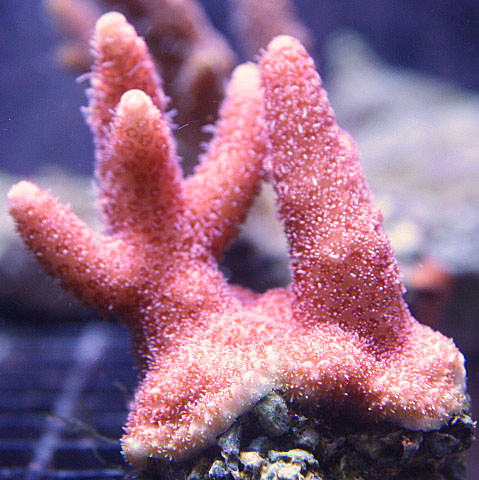
Despite being a more challenging coral to keep, Acropora corals are beautiful live corals that come in a variety of colors and forms. In general, high lighting intensity and strong current paired with stable water parameters should help your Acropora sp. thrive. They are non-aggressive and can be one of your larger corals in your aquarium. If you do not give them enough space, you will need to frag them to keep these corals from out growing your aquarium. They are also hermaphroditic and will spawn if conditions are right. Acropora corals in the home aquarium like swirling or turbulent water movement to do best.
Anacropora
Check our current stock</a >Common Species: A. spinosa, A. forbesi
The common name for Anacropora spp. is briar coral. Briar corals have similar growth forms to Acropora corals with many tapered branches. These are usually found on soft substrates, like the muddy bottoms of lagoons. They like lower water flow, but will adapt to a variety of water conditions. Coinciding with their prevalence in lagoons, briar corals will thrive in water with high nutrient content and turbidity.
Anacropora corals can be white, cream, green, and brown. Unlike Acropora, Anacropora corals are slow growing. Their corallites are spaced further apart on their skeleton and are much smaller. Their skeletons are typically thinner than those of Acropora corals, and therefore, are more prone to breakage. As a result these corals are more difficult to ship making aquacultured</a > coral varieties more desirable for the saltwater aquarium hobbyist. More information is needed for this genus.
Astreopora
Check our current stock</a >Common Species: A. myiophthalma, A. listeri
The common name for Astreopora corals is star coral. There are 14 known species. They are typically massive or hemispherical, but they can also take on other growth forms such as branching, laminar, and foliaceous (vase like). When massive, you can tell them apart from other families because of their more porous skeleton and conical shaped corallites. Astreopora spp. have 24 tentacles on their polyps. Star corals come in a variety of colors, including brown, green, pink, blue, and the most common blue-white. They will never be mustard in color. Star corals are found in the Indo-Pacific region and the Red Sea, and are uncommon on reef flats as they do not prefer to be exposed to the air. Astreopora corals are particularly fond of strong water current and clear waters, such as on the fore-reef slope. They also will colonize deeper water with large heads that can grow up to 12 feet in diameter or in laminar form.
Astreopora corals are important ecologically because at least 2 species of barnacle (Hiroa stubbingsi and Cionophora soongi) live exclusively on them. They are also a home for burrowing polychaete worms. If you purchase a wild collected corla of this species you may have an incidental guest for your home aquarium.
Enigmorpora
Check our current stock</a >Single Species: E. darveliensis
There is no common name for this species. It was has been collected and described (in 2003 and 2008), and more data is needed for this species. E. darveliensis is found in the Philippines and Malaysia. This coral is usually not be available for import. In 2003, it was found “at 2m depth in a turbid location with moderate currents” (Ditlev, 2003). It is threatened by the loss of reef habitats in the Indo-Pacific ocean.
Montipora
Check our current stock</a >Common Species: M. capricornus, M. undata
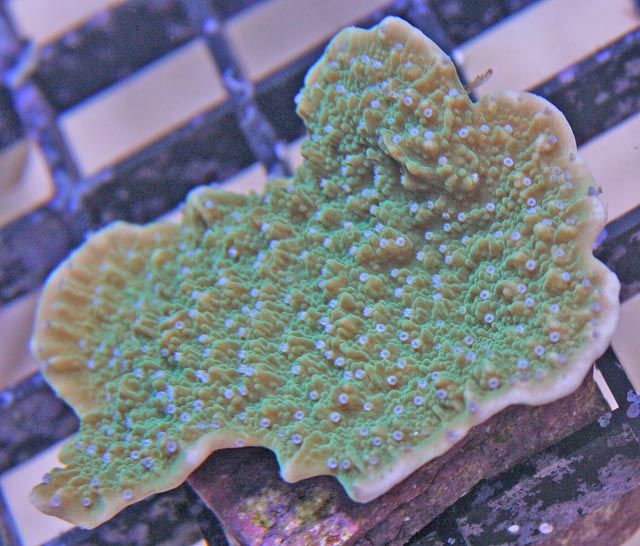
Common names for Montipora corals are velvet coral, velvet branch coral, and velvet finger coral. Like Acropora spp., Montipora spp. come in an abundance of growth forms, sometimes having several growth forms in the same colony. These may be branching, foliaceous, laminar, encrusting, and fingered, just to name a few. This doesn't make it easy to tell them apart by sight. Their encrusting forms may have little mounded formation. Montipora corals are second only to Porites for having the smallest corallites. These corals have porous skeletons with “fuzzy” polyps (hence the “velvet” denomination). Montipora corals can be brown, green, lavender, and pink. Recently with the modern saltwater LED lights, other color combination are appearing. The coenosarc (tissue covering the skeleton and connecting the polyps) is often of contrasting color with the polyps. The edges of plates and vases may also be of a contrasting hue from the rest of the coenosarc.
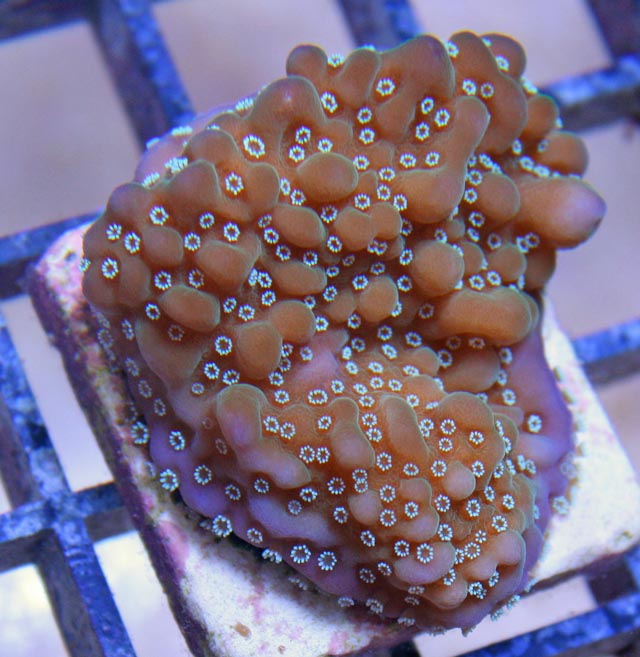
Velvet corals are found in a variety of water and lighting conditions. These corals are very tolerant and can take low to high water current and turbid to clear waters. They are a good beginner SPS coral. Please research a particular species to ensure its proper placement in your reef aquarium as they can be fast growers. They are non-aggressive, so should be placed away from other more aggressive corals.
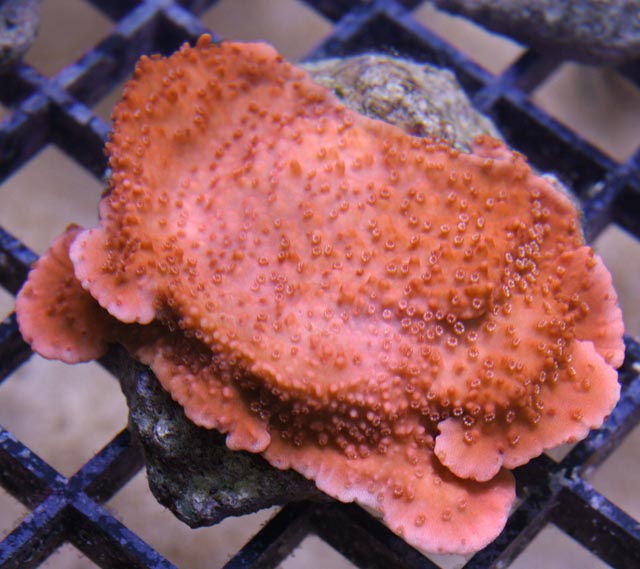
Although tolerable of all lighting conditions, they will become drabber in color in lower light and higher nutrients. These corals propagate well through fragging and can be collected easily without permanent damage to the mother colony. These corals are particularly abundant in the wild, and collection for the saltwater hobby hasn't shown to be overly damaging to this coral population. However, since they do reproduce so quickly and with such success in captivity, it is recommended to acquire an aquacultured</a > variety for the best success.
References
Achituv, Y. & Newman, W.A. (2002). The barnacles of Astreopora (Cirripedia, Pyrgomatini/Scleractinia, Acroporidae): organization plans, host specificity, species-richness, and geographic range. </em >Journal of Natural History, Vol. 36 (4): 391-406.
Acroporidae. (2011). Retrieved on May 26, 2011 from http://en.wikipedia.org/wiki/Acroporidae</a >
Borneman, E. (2001). Aquarium Corals: selection, husbandry, and natural history. Neptune City, NJ: T.F.H Publications.
Calfo, A.R. (2002). Book of Coral Propagation: A concise guide to the successful care and culture of coral reef invertebrates </em >(Vol. 1). Monroeville, PA: Reading Trees.
Ditlev, H. (2003). Scleractinian corals (Cnidaria:Anthozoa) from </em >Sabah, North Borneo</em >. Description of one new genus and eight new species, with notes on their taxonomy and ecology. Zool. Med. Leiden, Vol. 77(9): 193-219.
